Make a Pilgrimage to the Isle of Gigha
‘God’s Island’The Island is situated off the West Coast of Kintyre, 19 miles North of Campbeltown and directly opposite the village of Tayinloan. The island lies approximately 2 miles off the coast. A regular Ferry Service is available, and a farm tearoom is present in the immediate vicinity of the ferry terminus. The Isle of Gigha is seven miles long by a mile and half wide and only three miles from Kintyre peninsula.
Old Parish Church, Gigha (St Cathan’s)
Located uphill from the entrance to Achamore Gardens and the Village Hall – about 230 metres North - lie the remains of the former parish church of Gigha and Cara, which was dedicated to St Cathan (an Irish missionary of the 6th Century). Fairly well preserved, the church ruin probably dates from the 13th and stands within its own burial ground. Funerary monuments include an Early Christian Cross and Medieval tapered tombstones. The structure is of a simple rectangular plan and measures 11.6 metres West to East by 6.1 metres transversely over walls 0.8 metres in thickness.
Christianity came to Gigha around about 563AD with the missionary monk, St Columba, who was travelling up the coast of Argyll from Ireland to Iona. One of his contemporaries, a monk called Catan, subsequently built a cell at the site of a holy well, and this became Kilchattan church and graveyard serving the south of the island. There was another chapel to serve the north of Gigha, founded by a monk called Fionnlagan, also with a graveyard. The remains can still be seen in the field opposite Tarbert farm. There is a stone cross amongst a pile of stones. These large stones were burial markers which were cleared to the centre of the field in order to increase the area of agricultural land. There is also a chapel on the island of Cara, founded by a monk called Finla.
St Columba and his contemporaries belonged to the Celtic church, which was based on monasteries and missionary monks. By the 13th century the church was ruled from Rome with a parish system of bishops and priests. It was at this time that the Kilchattan church was built. It became a part of the protestant church, Church of Scotland, at the time of the Reformation in the 16th century and was used until the 18th century, after which it became a ruin. In 1712 a new church was built on the site which is now the hotel car park, and when that fell into disrepair another church was built in 1780 on the same site, a portion of the wall of that church being all that now remains.
By the early 20th century a new church building was needed and fortunately the minister at the time, Rev Donald MacFarlane, had been an architect. He therefore designed the present building, which was relocated on “Cnocan a' Chiuil” (the hill of music), and constructed from the black whinstone of the previous church. It was completed in 1923, but sadly Donald MacFarlane died in that year. The St Columba window at the front left of the church is dedicated to his memory.
When the church was built there was only one stained glass window, dedicated to those who gave their lives in the 1914-18 war. It depicts Jesus on the cross, with the words of Jesus on the night before he died, “Greater love hath no man than this, that a man lay down his life for his friends.” (John 15:13). Below the cross is the empty tomb reminding us that Jesus is alive today and that through faith in him we have the hope of eternal life.
Standing Stones on Gigha
The oldest monolith in Gigha today is probably that which stands forgotten near the farmhouse of Kinererach to the north of the island. It rises on the edge of the original road, where it is almost invisible in the field in which the farmhouse stands. Little remains but a stump. It has been reduced to a height of five feet, with a width of three feet and is somewhat oval in section; but the stump itself is broken, so that the shape is now rather that of a low seat with a back.
On the east side of the road, about 200 yards north east of Tarbert Farmhouse, on the narrow isthmus between the two bays, can be found The Stone of Tarbert - Carragh an Tairbeirt. It is 71/2 feet high, 34 inches across, 15 inches thick at the north edge and 9 inches at the south. The head of the stone is curiously shaped like a mittened hand held upright with the thumb slightly apart. It is not known the exact reason why this Standing Stone was originally erected, although there has been much speculation.
Just to the south of Tarbert (these names appear throughout the West of Scotland and means neck of land, over which to drag a boat), lies the site of another ancient 'chapel' with the battered remains of a standing cross to mark it. Fifty yards from it is the Holy Stone, bearing primitive cross-like and other incised markings. The theory is that it is pagan in origin, but became a preaching stone in later Christian times.
Cnoc A'Bhodaich (Hill of the Old Man)
Between Achamore and Leim (at the southern tip of Gigha), two curious stones crown the slight remains of a fortification: the Bodach and Cailleach. They were regarded in the old days as having mysterious powers and represented the old man and the 'hag', terrifying creatures who 'walk the heath at night'.
Beside the road a little further on is a landmark, known variously as The Druid Stone, Clach a' Thairbeirt and The Hanging Stone. The name, The Hanging Stone, came from a tradition that people who were found guilty at 'The Court Hill' nearby, had their heads positioned in the cleft of the stone and were then left to hang to their deaths.
Situated just west of the ruins of Kilchattan Church, is the Cnoc A'Charraidh (Hill of the Pillar) on which stands the inscribed Ogham Stone. This pillar is square in section, standing five feet nine inches from the ground and measuring 3 feet 9 inches in circumference at the foot. Throughout the years it has received a fair amount of knocks, and the weathering on the exposed side has made it difficult to get a perfect transcription of the original sculpturing. However Professor R A S Macalister has given the reading as 'VICULA MAQ COMGINI' - FIACAL SON OF COEMGEN - and holds the opinion that it is a Scottish inscription cut under Pictish influence. Although there are other suggestions as to the meaning of the words, it is a gravestone with the conventional type of inscription giving the name of the deceased and that of his father, and probably dates from the earliest settlements of the Scots in Dalriada.
- The Stone of Tarbert - Carragh an Tairbeir
- The Druid Stone, Clach a' Thairbeirt and The Hanging Stone
Clachan Church
Clachan was the ancient seat of the Church in North Kintyre. The present traditional harled oblong kirk of around 1760-80 and replaced an earlier church on the site.
The village of Clachan is near the north western tip of Kintyre, and served for many years as the ecclesiastical centre for north Kintyre.The church was built around 1760 to replace an earlier building. Fragments of stones on the site suggest a very early Christian church, possibly dedicated to Columbanus, a disciple of St Columba.The age of the first church at Clachan is uncertain, but it must have been an ancient foundation, given the importance of Clachan as a church centre and the early dedication. The importance of Clachan is emphasised by a number of very worn early medieval grave slabs in the churchyard. The best of these have been gathered together under a lean-to in one corner of the churchyard to protect them from the weather.
Several of the stones are early medieval, one is an undecorated cross, and at least 2 are medieval slabs. Several of the slabs are carved with the symbol of a sword, and at least one with the symbol of a cross. One of the sword slabs also shows a pair of what appear to be hounds near the sword hilt. One slab shows an extremely well-carved side, decorated with a regular pattern of rectangles. Though most of the stones are very worn, the quality of the carving is striking.Many of the grave slabs are thought to commemorate the chiefs of Clan McAllister. Against the churchyard wall is an unusual carved stone with a Latin cross beneath a ring cross, both joined to a common stem.Though not as impressive as the grave slabs displayed at Saddell Abbey on the east coast of Kintyre, I quite enjoyed visiting the Clachan stones. Many of them are quite worn with time, but the setting is impressive and the village is quite pretty.Balinakill House, near the church, was the home of Coll McAlester, who in 1739 led a group of settlers to Cross Creek in North Carolina.
Balinakill House was also the home of Sir William Mackinnon (1823 - 1893), a native of Campbeltown who began as an apprentice to a grocer and became in time a wealthy shipowner. Mackinnon founded the British India Steam Navigation Company and the Imperial British East Africa Company, and left money in his will to 'provide a decent education to deserving Highland lads'.The result was the Keil school in Dumbarton, which closed in 2000. Mackinnon is buried in the churchyard at Clachan and his birthplace in Campbeltown in marked by a commemorative plaque.On Dunskeig hill, outside the village, are a series of three hill forts, one of which is vitrified.



